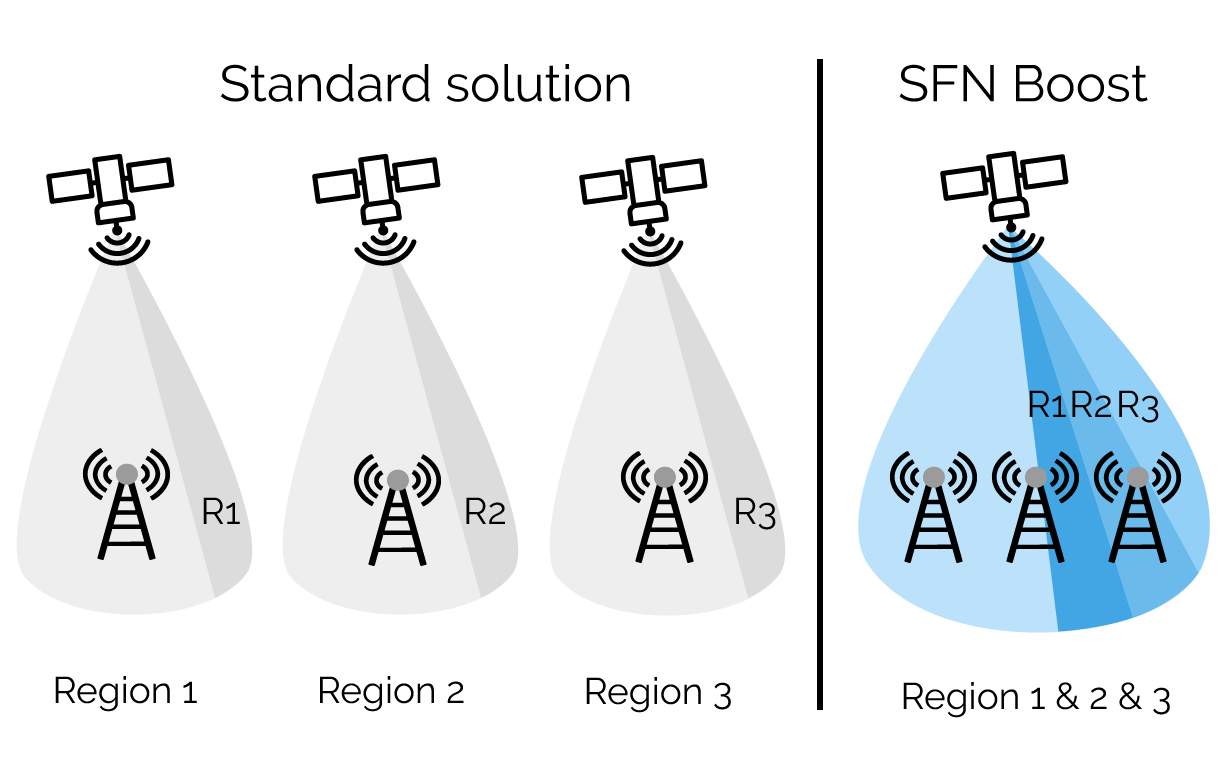
SFN Boost
DVB-SIS solution
SFN Boost is a cutting-edge solution for significant reduction (up to 98%) of satellite bandwidth used to feed terrestrial TV transmitters operating in Single Frequency Networks (SFN) mode.
SFN Boost offers broadcasters
unique solutions to 3 use-cases:
- Single satellite transmission to both terrestrial TV transmitters (DTT) and satellite home users (DTH)
- Cost-effective (single) delivery of regional TV content to terrestrial TV networks
- Cost-effective insertion of regional advertisements and Emergency Warning System (EWS)
SFN Boost is a unique DVB-SIS solution for

Parallel
satellite broadcast
Single satellite transmission to both terrestrial TV transmitters and satellite home users
Extends TV availability to areas with low terrestrial TV coverage
100% satellite cost savings for satellite broadcast to home users
Complete nationwide TV services coverage


Regional
advertisements
Cost-effective insertion of regional advertisements
Eliminates the need for extra satellite capacity for each region
Allows insertion of recorded content such as ads, weather forecast, news, info, emergency warnings, etc.
Addresses advertisers’ growing demand for low cost regional advertisement


Regional
TV programs
Cost-effective delivery of regional TV content to terrestrial TV networks
More than 95% satellite capacity savings for each additional region
Avoids repeated transmission of national TV content for each region
Supports radio efficient single frequency TV networks (SFN)

Centralized and Distributed (DVB-SIS) Architecture
SFN Boost also gives broadcasters the option to choose between centralized and distributed architecture. The distributed solution is compliant with DVB-SIS standard ETSI, while the centralized, on the other hand, follows proprietary solution.
The centralized version uses a patented method that performs in-depth content analysis across multiple layers and compresses duplicated packets. The centralized architecture complements and enhances the DVB-SIS standard by offering additional features. For example, it does not rely on GPS synchronization, which meets the government needs for critical infrastructure independency. Moreover, it can transmit the control stream via any distribution path, which provides more flexibility and redundancy. Finally, it supports plug-and-play installation of adapters into the existing DVB-T2 installations.

Key features
Single satellite transmission to both terrestrial TV transmitters (DTT) and satellite home users (DTH)
Cost-effective (single) delivery of Regional TV content to terrestrial TV networks
Cost-effective insertion of Regional Advertisements and Emergency Warning System (EWS)
Possibility to choose between Distributed (compliant with DVB SIS standard ETSI) and Centralized architectures
Centralized version additional features:
Does not rely on GPS synchronization
Can transmit signalization (metadata) via any distribution path
Supports plug-and-play installation of adapters into the existing DVB-T2 installations
